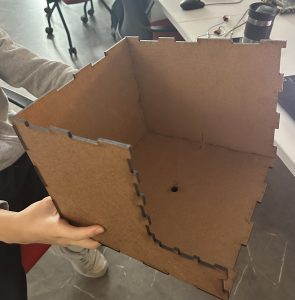We have noticed that it will be very difficult to make the card dispenser dispense one card at a time, both due to inaccuracies of the 3D printer and having to calibrate the rollers and the pressure on the cards very accurately. We will try to identify issues of each trial and make improvements to each prototype to carefully calibrate for the next couple weeks. We are not pressed for time on this at the moment as the software needed for the dispenser’s full functionality is still being implemented.
Furthermore, similar to last week, since we just got our relevant parts so we weren’t able to fully test rotating the platform. These are scheduled to be handled next week, and we plan to make changes to the motors and the motor shield if needed as soon as possible.
There were no significant changes in the system design. We had some schedule changes that occurred due to delay in getting the parts, but it’s mostly changing the orders of 2 tasks, so everyone is on schedule.

Part A written by Jason Stentz, Part B written by Thomas Kang, Part C written by David Peng.
Part A: Although our project is not directly geared towards drastically improving public health, safety, and welfare, there are a few key benefits. Since we are removing the burden of managing game flow, players will be more social during the game instead of worrying about managing the game. Of course, increased social interaction is almost always a health benefit. Also, UNO is a cognitively stimulating game. It may not seem like it on the surface, but there is actually quite a bit of strategy involved in picking when to play, draw, or call a bluff. Creating an automated UNO device will attract others to the game, promoting a healthy game to stimulate the mind. Lastly, an automatic UNO device will lower the barrier to entry for new players, since the rules will be enforced for them! This will mean they will have less anxiety when playing for the first time. Overall, an automatic UNO controller will allow for more social interaction during the game, reduce anxiety for new players, and help spread a cognitively stimulating game.
Part B: While UNO is one of the most popular card games around the world, there are a good amount of people who are not as familiar with it, especially in Asian countries. Also, even among people who know how to play the game, depending on where and who they played the game with, they can have their own sets of rules. This potentially leads to people getting into arguments or getting too focused on the game itself all the time that they miss out on the opportunity of using UNO as an opportunity to bond with other people and socialize. Our machine will be able to not only educate and assist people who have never played the game, but also eliminate arguments over rules as well as facilitate people’s social interaction by automating the flow of the game. This way, regardless of people’s background in the game, everyone will be able to enjoy the game to the fullest.
Part C: With UNO being one of the most played card games in the world, there is a large group of people, both casual, and competitive, who can benefit from this product. For example, in the UNO world championships, the need for dealers would be reduced as our product can manage the games being played with high accuracy and efficiency. It can also allow for other tournaments with lower budgets to use this machine to control the games instead of having to hire a large number of dealers. The automatic scoring will also augment the home experience and introduce more people to the game and make it more engaging.






